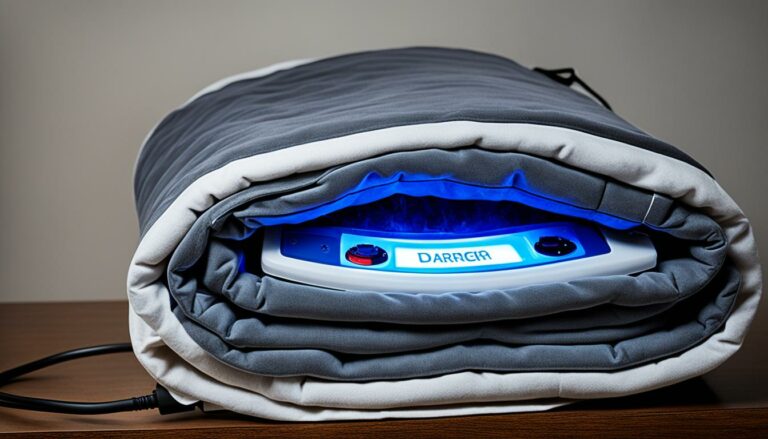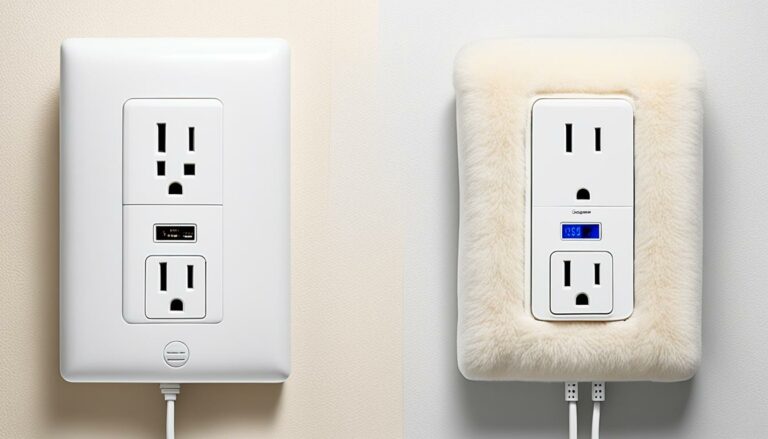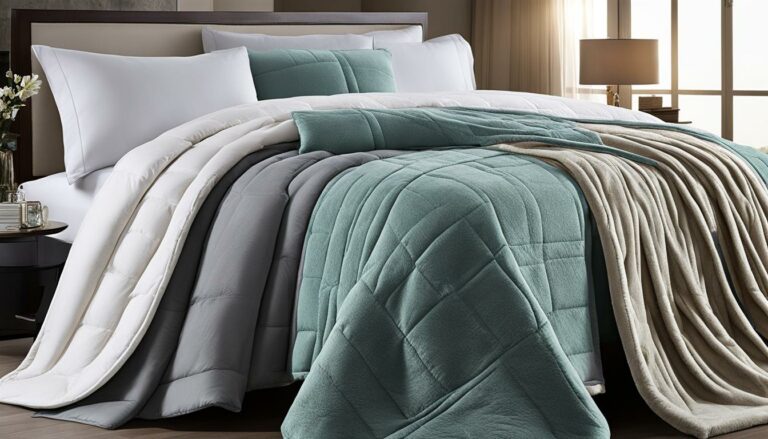Heated Blanket Burns: Prevention and Treatment Tips
Eric Christie stands as a luminary in the bedding industry, with a career spanning nearly four decades since the early 1980s. His journey through the world of bedding has seen him wear many hats – a manufacturer, designer, and retailer, showcasing his versatility and expertise in Read more...
pillowsandbedsheets.com and its partners may earn a commission if you purchase a product through one of our links
Electric blankets can provide warmth and comfort during cold winter months, but it’s important to use them safely to prevent burns and other accidents. While new electric blankets have safety features to reduce these risks, older or damaged blankets can be hazardous. In fact, according to Columbia University, 99 percent of electric blanket fires are caused by blankets that are 10 years old or older.
To prevent burns from heated blankets, it’s essential to follow these safety tips:
Key Takeaways:
- Electric blankets can pose a risk of burns and fires if not used properly.
- Older or damaged blankets are more likely to cause accidents.
- Follow safety tips to prevent burns from heated blankets.
- Using newer blankets with safety features can help minimize risks.
- Avoid using blankets that are 10 years old or older.
Are Heated Blankets Safe for Everyone?
While electric blankets can provide warmth and comfort during the colder months, it’s important to consider some factors to ensure their safe use. Generally, electric blankets are safe when used correctly, but certain individuals should take extra precautions to minimize potential risks. Let’s explore some key considerations:
Heated Blanket Fire Risks:
Electric blankets, like any electrical device, carry a small risk of fire hazards if not used properly. To reduce the risk of fire, never fold or bunch up your electric blanket when it’s in use, as this can cause overheating. Additionally, avoid placing objects on top of the blanket, such as pillows or heavy bedding, which can restrict airflow and increase the chances of overheating. Always follow the manufacturer’s instructions and safety guidelines to prevent fires.
Electric Blankets and Cancer:
There have been some concerns about the potential link between electric blankets and cancer. However, current research suggests that there is no direct evidence to support this claim. The electromagnetic fields generated by electric blankets are generally low and considered safe. Nevertheless, if you have specific concerns or a history of cancer, it’s best to consult with your healthcare provider for personalized advice.
Electric Blankets and Pregnancy:
During pregnancy, it’s natural to seek warmth and comfort, but it’s essential to use heated blankets with caution. Moderate use of electric blankets during pregnancy is generally considered safe; however, it’s crucial to follow specific guidelines. Avoid placing the electric blanket directly on your abdomen and ensure it is not set to high temperatures that can cause excessive heat exposure. If you have any concerns, always consult with your obstetrician or healthcare provider.
Electric Blankets and Diabetes:
Individuals with diabetes may experience decreased sensitivity to temperature changes, making it important to be cautious when using heated blankets. Ensure that the blanket is in good condition and does not have any exposed wires or damaged elements that could cause burns. It’s also advisable to keep the blanket on a low setting and avoid falling asleep with it to prevent the risk of burns or overheating.
Electric Blankets and Poor Circulation:
If you have poor circulation, it’s crucial to be mindful when using heated blankets. While they can provide temporary warmth and comfort, prolonged exposure to high heat can further impair blood flow and potentially cause harm. It’s recommended to limit the usage time and keep the temperature at a moderate level to avoid any negative effects on circulation.
Remember, the information provided here is general guidance, and it’s always important to listen to your body and consult with a healthcare professional if you have any specific concerns or underlying health conditions. Now, let’s move on to Section 3 and learn how to use heated blankets safely.
How to Use Heated Blankets Safely
To ensure the safe use of heated blankets, follow these guidelines:
- Inspect your blanket: Before use, carefully check your electric blanket for any signs of damage, such as frayed wires or worn-out fabric. If you notice any issues, refrain from using the blanket and consider getting it repaired or replaced.
- Read the instructions: Familiarize yourself with the manufacturer’s guidelines and safety instructions provided with your heated blanket. This will help you understand how to properly use and care for your blanket.
- Choose the right temperature: Adjust your heated blanket to a comfortable temperature that does not exceed the recommended setting. Higher temperatures may pose a higher risk of burns or discomfort.
- Avoid sleeping with the blanket on: It is generally not recommended to sleep with a heated blanket turned on. Instead, preheat your bed and then turn off the blanket before getting in.
- Never fold or bunch the blanket: Ensure that your heated blanket is spread out evenly and flatly on the bed. Folding or bunching the blanket can result in overheating and potentially cause burns.
- Don’t place heavy objects on the blanket: Avoid placing heavy items, such as books or furniture, on top of the blanket. This can create excessive heat buildup and increase the risk of burns.
- Keep it clear of pets and infants: Pets and infants may inadvertently damage or pull on the wires of a heated blanket. To prevent accidents, keep them away from the blanket while it is in use.
- Turn off and unplug when not in use: When you’re finished using the heated blanket, turn it off and unplug it from the power source. This will help prevent any accidental overheating or electrical hazards.
By following these electric blanket usage tips and practicing safe practices, you can enjoy the warmth and comfort of a heated blanket while minimizing the risk of burns and accidents.
Remember that the improper use of heated blankets can lead to potential safety hazards. If you have any concerns or questions about electric blanket safety, consult the manufacturer’s guidelines or seek advice from a qualified professional.
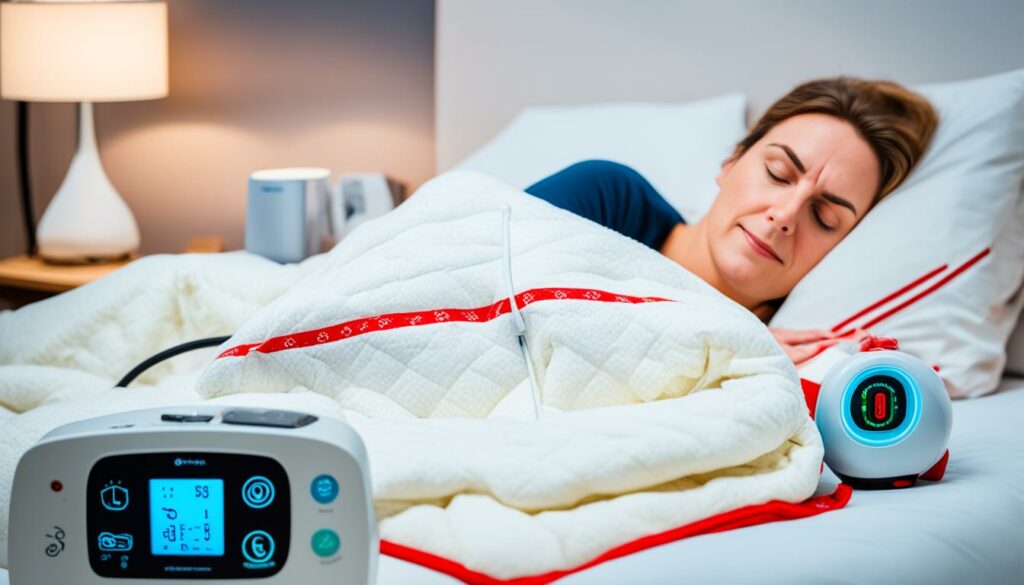
Potential Risks of Heated Blankets and Their Treatment
While the risk of burns from heated blankets can be minimized through proper usage and maintenance, accidents can still happen. If you or someone you know sustains a burn from a heated blanket, here are some general guidelines for treatment:
- Remove the source of heat: Turn off and unplug the electric blanket to prevent further injury.
- Cool the burn: Run cool (not cold) water over the burn for about 20 minutes or until the pain subsides. Avoid using ice or very cold water as it may damage the skin further.
- Gently clean the burn: Use mild soap and water to gently clean the burn area. Avoid using harsh or abrasive cleansers that may irritate the skin.
- Apply a sterile dressing: Cover the burn with a clean, non-stick sterile dressing to protect it from infection. Avoid using adhesive bandages directly on the burn.
- Seek medical attention: If the burn is severe, covers a large area, or shows signs of infection (such as increased redness, swelling, or pus), it is important to seek medical attention immediately.
It’s essential to remember that these guidelines are for general treatment of minor burns. For more severe burns or if you have any concerns, consult a healthcare professional for proper evaluation and treatment.
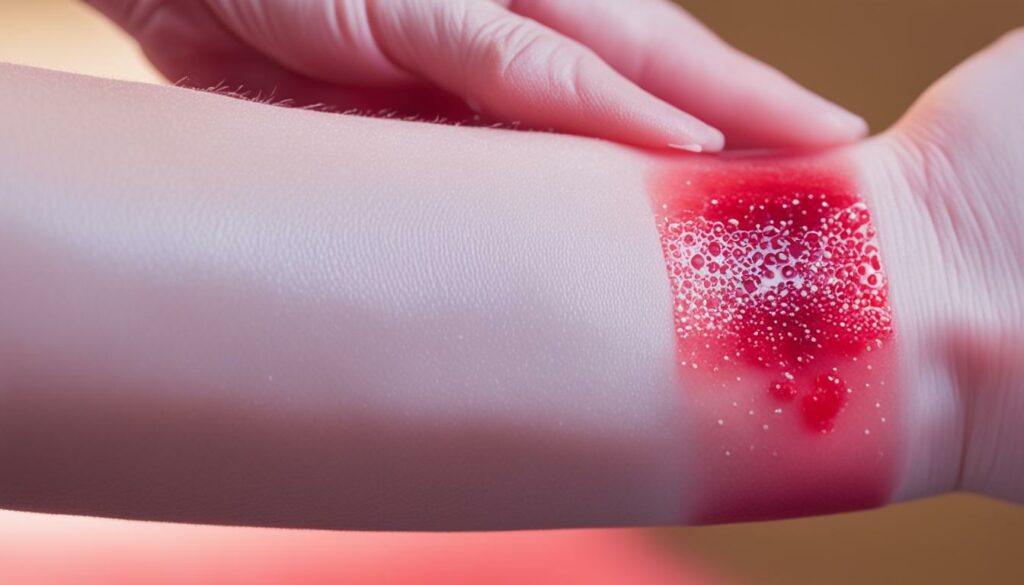
| Burn Severity | Treatment |
|---|---|
| Mild superficial burn (1st-degree) | – Cool the burn with water – Apply aloe vera gel or a mild over-the-counter burn ointment – Cover with a sterile dressing |
| Partial-thickness burn (2nd-degree) | – Cool the burn with water – Do not pop or break any blisters – Apply a specialized burn cream or ointment – Cover with a sterile dressing |
| Full-thickness burn (3rd-degree) | – Cool the burn with water – Do not remove any clothing stuck to the burn – Cover with a clean, dry cloth or nonstick dressing – Seek immediate medical attention |
Electrical Burns and When to Seek Medical Care
Electrical burns can occur when the body comes into contact with various sources of electricity, such as lightning, household current, job site accidents, or contact with electrical devices. These burns can range from minor injuries to severe, life-threatening conditions. It’s important to understand the potential risks and know when to seek medical care.
Types of Electrical Burns
Electrical burns are classified into three main types based on the severity and depth of the injury:
- Low-voltage burns: These burns typically occur due to household current or minor electrical accidents. They usually affect the skin’s surface and may cause pain, skin discoloration, and blisters.
- High-voltage burns: High-voltage burns occur when individuals are exposed to industrial or high-tension electrical currents. These burns can penetrate deep into the tissues and organs, causing significant damage. The skin may appear blackened or charred.
- Flash burns: Flash burns occur when individuals are exposed to an electrical explosion or arc flash. These burns are primarily thermal and can cause significant damage to the skin, eyes, and respiratory system.
In addition to burns, electrical accidents can also cause internal injuries, such as damage to the muscles, nerves, and organs.
If you or someone you know has experienced an electrical burn, it’s important to assess the severity of the injury and seek medical attention accordingly.
When to Contact a Doctor
While minor electrical burns can often be managed with basic first aid, it’s crucial to contact a doctor in the following situations:
- If the electrical burn is severe, covering a large area of the body, or involving sensitive areas such as the face, eyes, hands, feet, or genitals.
- If there are signs of a second or third-degree burn, including deep tissue damage, charred or white skin, or the formation of blisters.
- If the burn is accompanied by symptoms such as difficulty breathing, chest pain, or an irregular heartbeat.
- If the individual experiences numbness or weakness in the affected area.
- If there is suspicion of internal injury, such as muscle, nerve, or organ damage.
- If the electrical burn was caused by a high-voltage source, such as an industrial accident or lightning strike.
It’s important to note that even if a burn initially appears minor, complications can arise in the days following the incident. Therefore, it’s always advisable to consult a healthcare professional for proper evaluation and treatment.
| Severity | Characteristics | Treatment |
|---|---|---|
| Minor Burns | Redness, pain, and superficial blisters. | First aid measures such as cooling the burn with cold water and applying a sterile dressing. |
| Moderate Burns | Deep burns, extensive blistering, and significant pain. | Immediate medical attention, wound cleaning and dressing, pain management, and possible referral to a burn specialist. |
| Severe Burns | Deep tissue damage, charred skin, and potential organ involvement. | Emergency medical care, advanced wound management, fluid resuscitation, pain control, and specialized burn treatment. |
Remember, electrical burns can cause serious harm to the body and should not be taken lightly. Seeking prompt medical care is essential to assess the extent of the injury and ensure appropriate treatment.
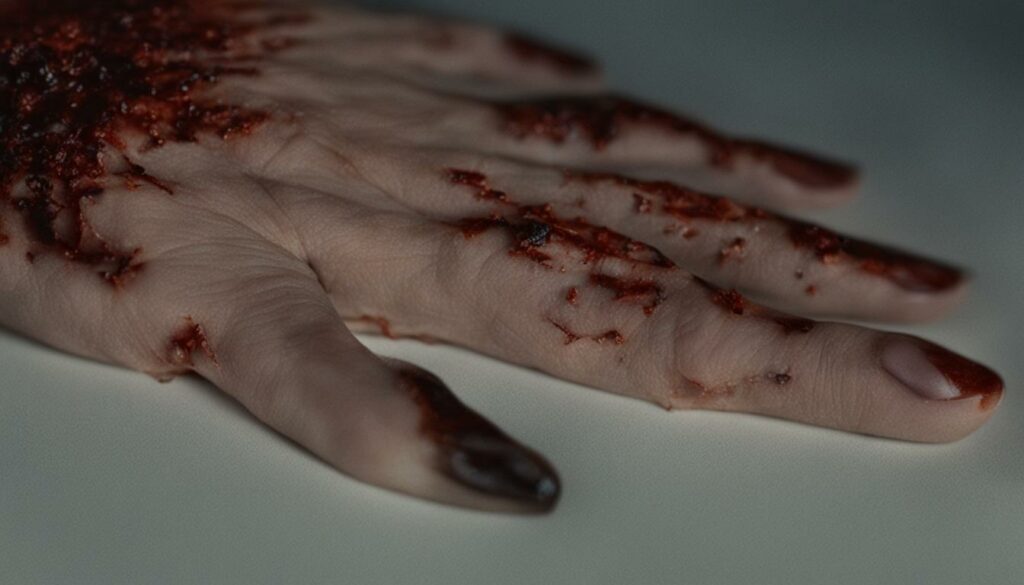
Consult a medical professional for a comprehensive evaluation of your electrical burn injury.
Conclusion
Heated blankets can be a cozy addition to your winter nights, but it’s crucial to prioritize safety to prevent burns and other accidents. By following these essential safety tips, you can enjoy the warmth of a heated blanket without compromising your well-being.
Firstly, opt for newer blankets with built-in safety features. These modern blankets are designed to provide better temperature control and reduce the risk of overheating. Additionally, regularly inspect your blanket for any signs of wear or damage. If you notice frayed wires or exposed heating elements, it’s time to replace the blanket to avoid potential hazards.
Next, practice safe usage habits. Avoid folding or bunching the blanket while in use, as this can create hotspots and increase the risk of burns. Never fall asleep with the heated blanket turned on, as prolonged exposure to excessive heat can lead to serious injuries. Finally, always unplug the blanket when not in use to minimize the risk of electrical malfunctions or fires.
If you have any specific concerns about using a heated blanket due to underlying health conditions or pregnancy, consult with a healthcare professional. They can provide personalized advice and ensure that using a heated blanket is safe for you.
Remember, with proper precautions and attentive usage, you can stay warm and cozy under a heated blanket while avoiding potential burns and accidents. Prioritize your safety, follow these guidelines, and enjoy the comfort of a heated blanket throughout the colder months.
FAQ
Are heated blankets safe for everyone?
While electric blankets are generally considered safe when used correctly, certain individuals, such as those with poor circulation, diabetes, or who are pregnant, should take extra precautions when using heated blankets. It is always important to consult with a healthcare professional if you have any specific concerns related to using a heated blanket.
What safety tips should I follow when using a heated blanket?
To ensure the safe use of heated blankets, follow these guidelines:
– Only use newer blankets with safety features.
– Follow the manufacturer’s instructions for usage and maintenance.
– Avoid using damaged or outdated blankets.
– Never fold or tuck the blanket in tightly.
– Do not use heated blankets while sleeping or leave them unattended.
– Keep the blanket away from children, pets, and liquids.
– Do not place heavy objects on top of the blanket.
– Inspect the blanket for any signs of wear or damage before each use.
What should I do if I or someone I know sustains a burn from a heated blanket?
If you or someone you know sustains a burn from a heated blanket, follow these general guidelines for treatment:
– Remove any clothing or jewelry around the burned area.
– Run cool (not cold) water over the burn for a few minutes.
– Cover the burn with a clean, dry cloth or bandage.
– Do not apply any creams, ointments, or adhesive bandages to the burn.
– Seek medical attention if the burn is severe or covers a large area, or if there are signs of infection.
What are the potential risks of using heated blankets?
The potential risks of using heated blankets include burns, fires, and electric shock. These risks can be minimized by using newer blankets with safety features, avoiding damaged or outdated blankets, and practicing safe usage habits.
What should I know about electrical burns and when should I seek medical care?
Electrical burns can be caused by various sources of electricity, and it is important to seek medical care for electrical burns in the following situations:
– The burn is deep or covers a large area.
– The burn appears white or charred.
– The person is experiencing difficulty breathing or has sustained an electrical injury to the head, neck, or face.
– The person is having chest pain, irregular heart rhythm, or other signs of a serious injury.
How can I ensure the safe use of heated blankets?
To ensure the safe use of heated blankets, follow these safety tips:
– Use newer blankets with safety features.
– Avoid using damaged or outdated blankets.
– Follow the manufacturer’s instructions for usage and maintenance.
– Never fold or tuck the blanket tightly and do not use it while sleeping or leave it unattended.
– Keep the blanket away from children, pets, and liquids.
– Inspect the blanket for any signs of wear or damage before each use.
Eric Christie stands as a luminary in the bedding industry, with a career spanning nearly four decades since the early 1980s. His journey through the world of bedding has seen him wear many hats – a manufacturer, designer, and retailer, showcasing his versatility and expertise in Read more...



